Game quality is all that matters
Recently I got into a small discussion with a few other devs over how much your reputation as a developer matters. The automatic position most devs have on this is that it matters quite a lot: if you have a good reputation further releases will be more likely to succeed, whereas if you have a bad one further releases will be more likely to flop.
I disagree with this very strongly. I believe that the only thing that matters for a game’s success is its quality, and amassing an audience as a developer has extremely limited effects on the performance of any of your subsequent games. I also believe that people vastly overestimate how much publishers, streamers, youtubers, and marketing in general contributes to a game’s success. And in this post I’ll make the argument for why I believe this to be the case.
According to SNKRX’s reviews I am a “raving NFT lunatic”, a “deranged NFT shill”, trying too hard to be an “enlightened stoic online”, “arrogant”, and “genuinely insane”. Some of these may be true. But not only that, I got into a small spat with a group of very influential streamers and youtubers in the roguelite scene last year, and I’m pretty sure they won’t play any of my games in the future.
So clearly, my reputation is in shambles. I already lost all my money because I bought 3 apes and they got stolen, and now any game I make in the future won’t make any money either. It’s literally and unironically over for me. At this rate I’ll be forced to go back to the favela and jerk off motoboys at the Cristo Redentor for 15 reais a man:
“Good morning”, indeed!
Now, if reality worked like people assume it does, this would have been a possible future. Fortunately for me, this won’t come to pass. First because I am very responsible with my money, and you’ll be surprised to know that to this day I haven’t spent a single dollar on buying an NFT. Shocking, I know.
But second because, and this is the most important part, 99% of players don’t care about who makes their games, they only care about if the game is good or not. This is a very hard fact for people to accept, but to explain it let me quote myself from a post I wrote 2 years ago, before SNKRX was released:
Your whole goal as an indiedev is to generate enough attention on your game so that Steam’s algorithm picks it up from there and propels it upwards. Once that happens, whatever reach you have in social media, however large you think it was, becomes very small. […] The majority of people playing your game will end up being people who simply don’t use social media.
I’m not the only one saying things like this. Here is Chris Zukowski, notorious indie game marketer and Steam understander, in a post written 3 months ago:
I saw this meme for something else and it dawned on me that this is essentially how the Steam algorithm works.
So when you send a newsletter out, or tweet about your game, or try to go viral, you are essentially knocking over that teeeny tiny domino. It is super super tiny.
When you do “community building” and get people to signup for your newsletter, join your discord, follow you on Twitter, you are building up potential energy that can knock over that first domino. That is essentially what that core group is. Your super fans who will buy everything you do whether they like your game or not.
BUT, if your game is really good and exciting, those community members tell their friends about your game…. and those friends will tell their friends. That is “word of mouth.” This happens enough, and the Steam algorithm will take note and see this “surge of people buying your game” and start showing it on the front page of steam.
That middle domino is the most important. You can build a great community, get them to act, and buy on day 1, but if your game isn’t exciting, they won’t tell their friends. Your community might support you because they like you, but if they just don’t like the game, they won’t recommend it.
And if you don’t believe in mere words and opinions, let’s take a look at this graph:

This is a graph of page visits to SNKRX’s steam page in its first month or so. Below is the graph focused on before NL played the game:
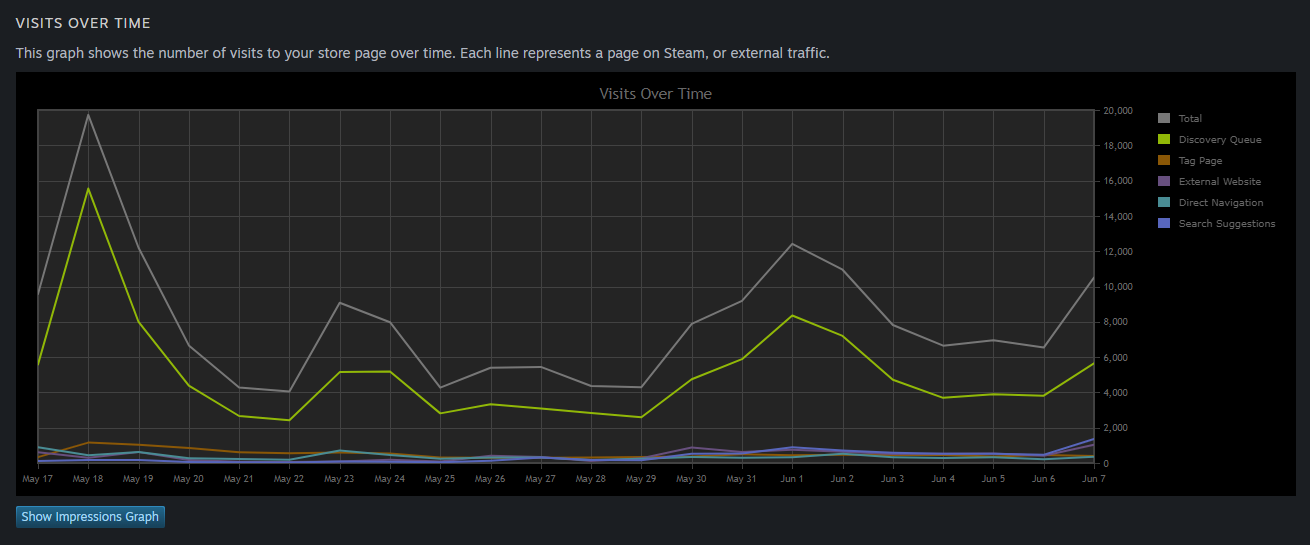
And here we can do a little exercise. What percentage of page visits is due to external sources such as my own marketing and streamers/youtubers, and what percentage is due to Steam’s own internal traffic? To make it easier to answer this question, here are the numbers as a table:
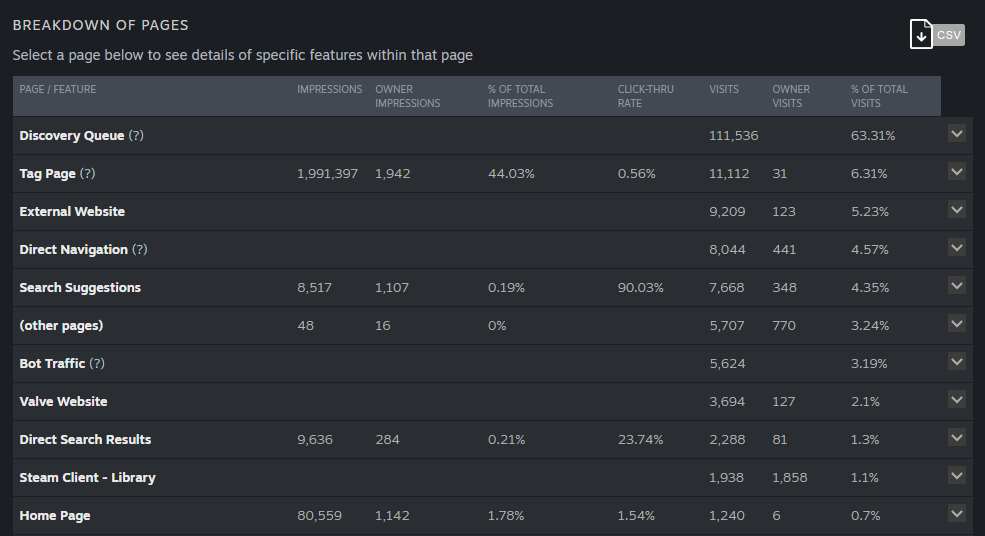
First we need to define what counts as Steam traffic and what counts as external traffic. From the picture above I think the ones that count as external would be external website, direct navigation, search suggestions, and direct search results, and everything else counts as internal Steam generated traffic.
If we add up the percentages we get 15.45% for external traffic and 76.76% for Steam’s traffic. This is roughly a 5X multiplier in Steam’s advantage. If we were to take the numbers as they are it means that all the marketing I did for SNKRX on my own + all the streamers and youtubers that played the game during that period (which are some of the same previously mentioned influencers that won’t play any of my games in the future) amount to 15% of page vists, while Steam itself amounts to 75-80% of it.
But of course, not all external website, direct navigation and search suggestion page visits can be counted as coming from either my or the influencers’ efforts completely. For instance, if someone posts a link to the game on a random discord server and people click it, that counts as a direct navigation hit. So the number for both mine and the influencers’ efforts are actually quite lower, as that 15.45% contains pretty much all of “word of mouth”.
Let’s say that the real number is half, so 7.27%. This means that Steam’s own traffic, for a game of middling quality such as SNKRX (in terms of Steam’s own internal stats for games) is an order of magnitude (10x) higher than any external traffic generated, including influencers.
Let’s see what number we get if we do the same exercise for the period after NL plays the game:
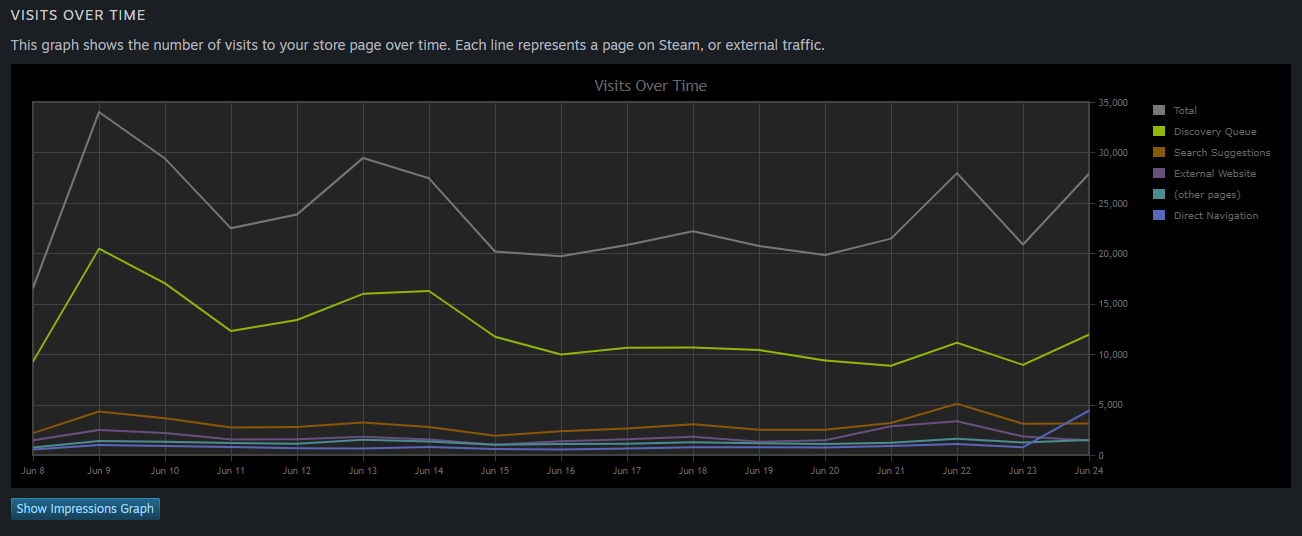
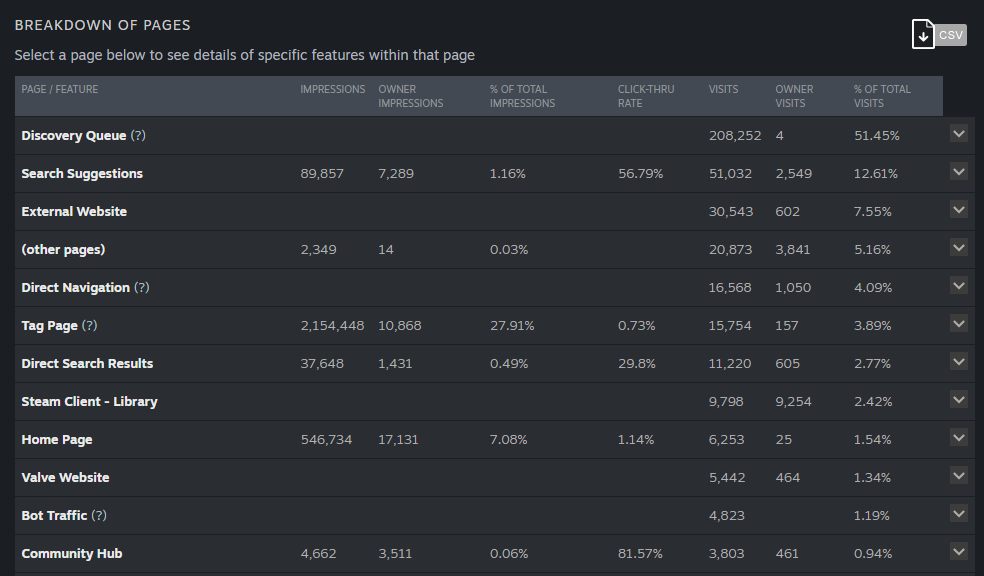
And if we add up the percentages again we get 27.02% for external traffic and 66.74% for Steam’s traffic. This is roughly a 2.5X multiplier in Steam’s advantage. Applying the same logic as before where the real number is half, we can say that it’s roughly a 5X multiplier instead.
There’s a difference here, from 5X to 10X, and there are multiple ways to explain it. One of them is that each game on Steam has something like an internal MMR score. I call this the “point of equilibrium”. This is a number or a set of numbers that tells Valve’s algorithm how “good” the game is, or how much it deserves to be shown on the store. For instance, a game like Slay the Spire most likely has a very high point of equilibrium, because it’s just a good game:
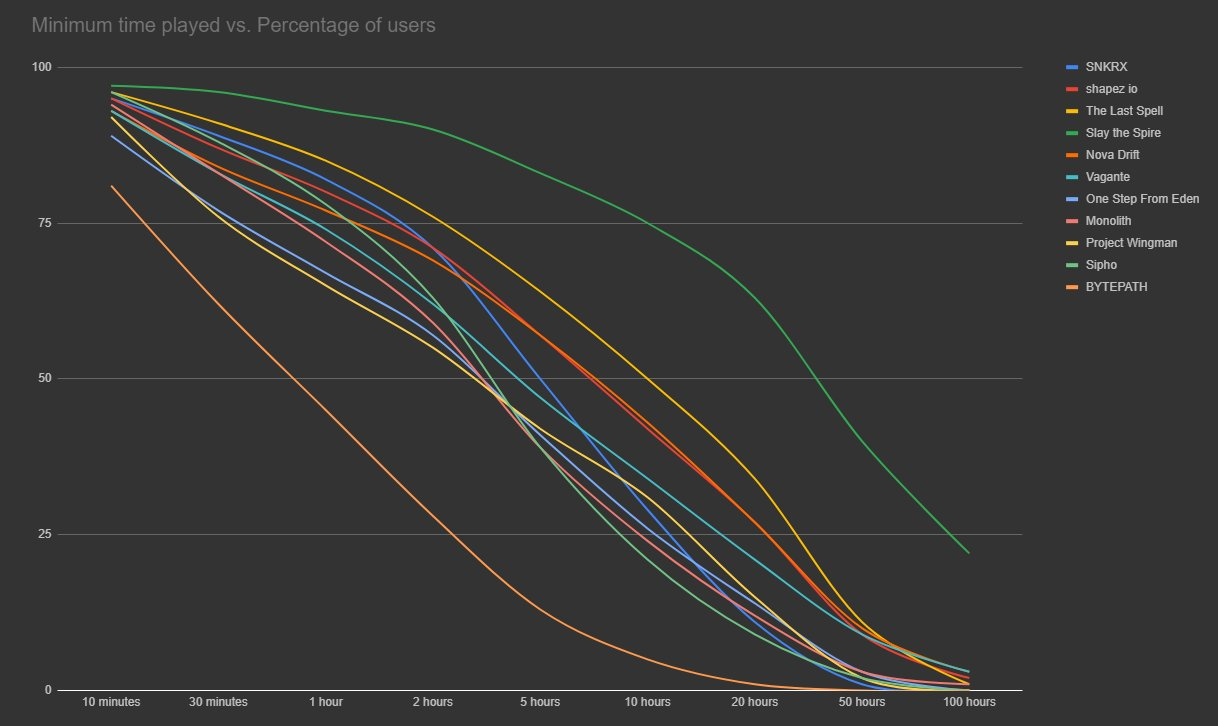
A game like SNKRX, for instance, has a lower point of equilibrium. It’s a pretty good one globally, but it’s certainly not the best. So what happens when a game like that is played by someone like NL, his audience’s size “carries” the game more in comparison to Steam because the game is closer to its point of equilibrium.
If this didn’t make sense, consider that the Steam store is a giant ad. Each game slot in the store is an ad slot, and all Valve’s algorithm is doing is picking games to show in each slot that will maximize the amount of money they make. As they show a game on the store more, this game will sell copies at a certain conversion rate. Games that have a better conversion rate will be shown more, because they make Valve more money.
Games that don’t sell as much are essentially costing Valve money, since they could be showing a game that performs better on that same ad slot. What this dynamic results in is that each game has its own point of equilibrium. This is how much the game is shown on the store while still having this operation be profitable for Valve.
For most games this dynamic means that they will never ever be shown after release day, but for some games like mine it means that they will be shown very consistently and predictably. Despite not getting any marketing by me or being played by influencers since like 1 year ago, SNKRX still generates a very consistent amount of money every month. And this consistent amount represents its point of equilibrium.
Chris has mentioned in this post that, based on his experience, games that make over ~$250k have a high enough point of equilibrium that showing the game is always profitable for Valve, and so those games get various additional benefits on the store on top of somewhat consistent income.
Another consequence of this dynamic is that this means Steam pays attention to any external traffic generated to a game, since that traffic will generate some sales, and then amplifies that until the game reaches its point of equilibrium. For SNKRX, in the before NL period, that amplification resulted in a 10X multiplier because it was further away from its true point of equilibrium, and then after NL it resulted in a 5X multiplier because it got closer to what it deserved.
The point being, the better the game, the higher its point of equilibrium, and the more Steam will show it to its users so it reaches the place it deserves. Consider a game like Vampire Survivors. As I write this it has 120k reviews. If Vampire Survivors’ dev did this same exercise I just did in this post, he would probably find a much much higher multiplier, like 100X or even 1000X? Simply because his game is that good, and thus his point of equilibrium is very high, and so Steam will just spam it until it stops making them money.
It’s very easy for people to think that something like Vampire Survivors happens primarily because of streamers/youtubers. They’re the most visible part of the game’s success, Valve won’t really go out of their way to say “actually it was all me” because they don’t need to, and the influencers of course are more than happy to take the credit.
But, you know, it’s just not what’s actually happening. I am, again, not really the only one saying this:

And here DUSKdev is basically saying, yes, influencers are not very good for sales conversions at all, they’re good in the same way that general marketing/ads are good. I think this second part of the argument is questionable given everything else I said in this post, but it’s a much more defensible position because, as he says, it’s much harder to quantify it and thus prove it right or wrong.
Still, you could object to all this on the grounds that without the initial external traffic that comes from primarily influencers, games would just be forgotten to the Steam void. After all, Vampire Survivors itself only got big weeks after release after SplatterCatGaming played it, so it’s a good example of a game where this definitely could have happened.
And this would be a reasonable objection. But it’s wrong. And to explain why this line of thinking is wrong it’s useful to look at this diagram:
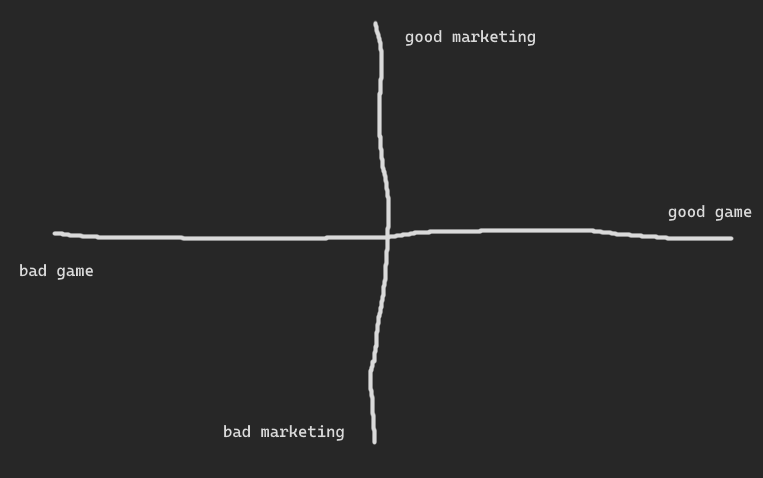
And so here we have 4 quadrants. On the x axis it goes from “bad game” to “good game”, which represents the game’s quality as assessed by the Steam algorithm, and on the y axis it goes from “bad marketing” to “good marketing”, which represents how much external traffic the game generates.
Let’s start with bad game + bad marketing. This is a game where when people visit the page, very few people buy it. Of those who buy it, they don’t play for that long, and also don’t tell their friends about it. This game has pretty poor stats and thus the algorithm, after trying it out for a few hours or a day after release, decides to pretty much not show it on the store anymore.
But on top of that, the game also has very poor external traffic. The developer has like 21 followers on twitter, and they made no effort at all to try to market the game anywhere other than their twitter page. If by some miracle a single influencer plays it, the effect of that will be small because the game just doesn’t convert nor spreads itself well. This is most indie games on Steam.
Now let’s look at bad game + good marketing. This is still a game with bad stats and bad conversion, but somehow it managed to generate quite a bit of external traffic. Maybe it has a well known publisher, or the developer is friends with a few big streamers. Whatever may be the case, the game is able to generate a good number of initial sales, but given that its stats are poor, the Steam algorithm won’t really share it with its audience that much.
This is a game with a low point of equilibrium, which means that the multiplier from Steam will be a very low number like maybe 1.5X or 2X, which will decrease more as time passes from release as the initial boost from external marketing fades. This is what happened to my first game, BYTEPATH:
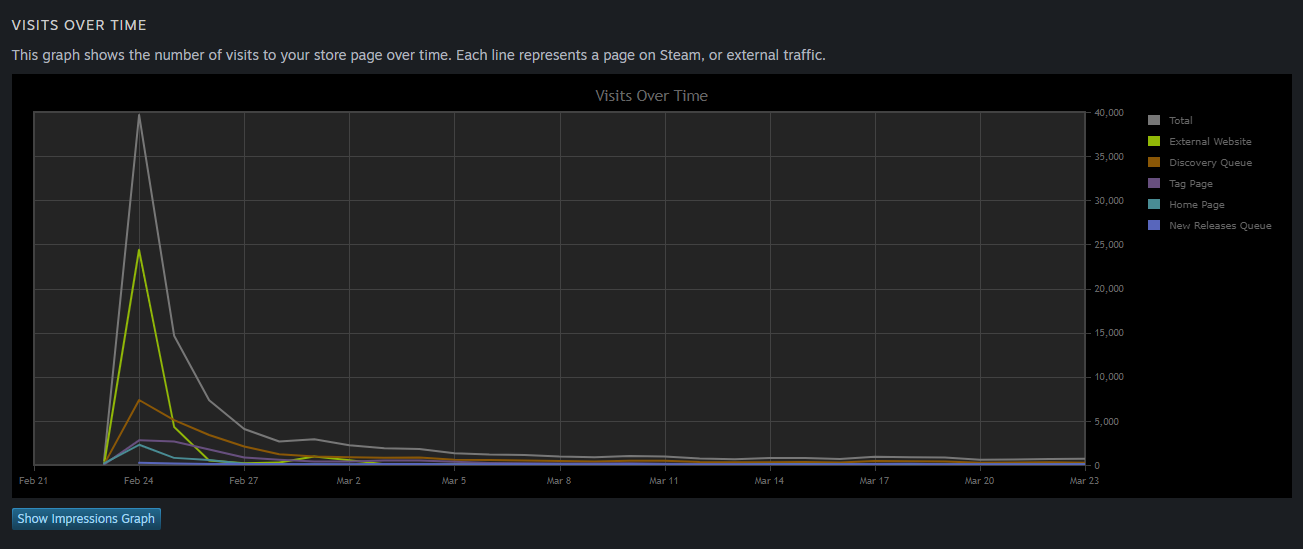

For BYTEPATH, most of the external marketing came from a reddit post instead of streamers, and you can see that in the graph, as that single reddit thread got the game a total of 24k page visits, and if you look at Steam’s contribution it’s significantly lower as a percentage than it was for SNKRX. If we add the percentages it’s 38.82% for external traffic and 59.51% Steam’s traffic, which is a multiplier of about 1.5X (or 3X if you divide external traffic by 2).
And so basically what happens with these kinds of bad games is that no matter how much marketing you do for them, Steam’s algorithm will just not go along with it because the game simply has bad stats. And as already mentioned, Steam does most of the work in terms of numbers, so if the game isn’t good it’s just not going to go very far.
Now let’s look at good game + good marketing. This is a good game with good stats, maybe it participated in one of the Steam demo festivals and amassed quite a lot of wishlists, and so when it releases it just does well and the algorithm propels it upwards from there, which makes influencers pick it up more and more and a positive feedback loop is established until it reaches its very high point of equilibrium.
Pretty much any game with over like 1000 reviews on Steam is a good example of this, and the number of reviews where they end up is their point of equilibrium. The most recent one I’ve been attention to at time of writing is Brotato, and it currently has about 1000 reviews growing at a good rate, so I’m curious on where it will end up.
Some games end up with around 5000 reviews, others around 10000, some 50000, some 100000 and so on. And these numbers differ because each game’s point of equilibrium and virality is different based on its quality, but Steam will work to eventually bring the game to its algorithmically correct place.
Finally, we have good game + bad marketing. This is the most interesting quadrant because it’s the one people have the most wrong opinions about. This is a good game, it has good stats, but it has not yet reached a wider audience because it has very poor external traffic. The previously mentioned “SNKRX before NL” would fit as an example of this, and we can also look at the analysis there for hints at what happens to these games.
And what happens is that Steam will work very hard to show the game to as many people as possible so that it reaches its true point of equilibrium, which is very high. This means that for this kind of game, each unit of marketing input is amplified by Steam a lot more than if it was a bad game. For SNKRX before NL this multiplier was 10X, for BYTEPATH (a bad game) the multiplier was 1.5X. For a game that is even better than SNKRX, like say Vampire Survivors for the first two weeks before it got discovered, the multiplier was likely a lot bigger than 10X.
And this is one of the reasons why I find it very hard to believe that things like “hidden gems” exist. Any game that is truly a hidden gem will have very good internal stats on Steam’s algorithm and any attention that it gets at all will propel it upwards tremendously until it reaches its point of equilibrium.
Similarly, this is why I believe that marketing in general doesn’t matter. It’s not necessarily that it doesn’t matter, but the amount that it matters compared to game quality is significantly misplaced in people’s mind.
If you have a good game, you need to do minimal marketing as the algorithm will do most of the work for you. If you have a bad game, no amount of marketing will make it perform. Given these two facts, the logical thing to focus on is to improve your game’s quality, yet people spend quite a lot of effort on marketing as if it mattered.
The only time marketing matters to some degree is on the good game + good marketing quadrant, where you know you have a good game and you want to optimize its results, but even that optimization will be somewhat muted, because if you have a good game and you, say, got as many wishlists as you could for it on one of those Steam festivals, it will pretty much be guaranteed to reach its equilibrium, whatever it may be. But your efforts won’t take a 5000 review equilibrium game to 50000 reviews, for instance, it just won’t happen.
All of this to say, with good games, any amount of attention is going to be amplified massively, so external sources are less responsible for it. The external sources need to exist in the first place, but it’s incorrect for any of them to claim particular responsibility for a good game’s success since any of them would have worked, if that makes sense.
And so with all this in mind we can go back to the start of this post. How much does your reputation as a developer matter? And the answer is that it clearly doesn’t matter at all.
The majority of people playing your game will come from Steam itself, and those people largely don’t care about who is making any particular game. More importantly, Steam itself doesn’t care about who the game is coming from, the game is either good or it isn’t, and it will be shown on the store more or less based on its stats.
Publishers also don’t matter. If you have a good game, it needs minimal marketing to reach its equilibrium, and any additional marketing on top of that will have diminishing returns, so a publisher helps very little. The publisher could theoretically raise the minimum number of sales on any game it releases, but even that is questionable.
If you look at Devolver for instance, which are considered to be one of the best indie publishers around and who have quite a big audience, you’d think that there are plenty of people who are like “I’ll buy anything Devolver publishes”, which should have a “raise the minimum” effect on any game they release. But if you look at their releases there are plenty that have around 500 reviews.
And so if Devolver’s baseline as a publisher is about 500 reviews, which would be, say 15000 sales, this is all they can realistically offer. And for the very successful games they publish, those games that get 50000+ reviews, you can conclude that they would have done about as well without the publisher’s involvement because that’s just their point of equilibrium.
Of course, if the publisher brunts a big portion of the cost of development then it’s a different story, but I know plenty of devs who get into deals with publishers without asking for any money upfront, which is quite obviously a huge mistake.
The role publishers play is actually quite different than most people think. And it’s the role of serving as a coping mechanism for developers who don’t want to accept that their game might be bad. The logic is very simple. The developer maybe has released a bunch of games that failed and reaches the conclusion that marketing matters a lot, but he doesn’t know how to do any marketing. So the publisher serves as this central point of focus for “thing that matters a lot that I don’t know how to do that explains why my games fail”, and it’s why publishers have such leverage when it comes to indie developers.
Of course, this leverage doesn’t exist in reality, but it does in the developer’s mind, and so publishers can continue to operate as they do and pretty much take advantage of people in a weaker and somewhat desperate position. Sad, but it’s a doggy dog world out there. Certainly you, dear reader, after reading this post and truly imbibing in the knowledge, won’t make the same mistakes those naive indiedevs make, right?
But not only don’t publishers matter, influencers also don’t. Consider the ones who have decided to not play my games in the future. Does this action significantly decrease the chances of any of my games succeeding? The answer to that is obviously no. If I make a bad game it doesn’t matter who plays or promotes it, the game won’t go beyond its point of equilibrium, which might in the tens or low hundreds of reviews.
And if I make a good game it will eventually reach its point of equilibrium with minimal marketing, as it did for SNKRX. For instance, I have about 2.5k followers on Steam. This is 2500 e-mails sent out when I release any game, which likely translates to a few hundred copies sold. This is more than enough as a starting point for any game. If it’s good it spreads from there, if it isn’t then it doesn’t.
And in the rare case where it is good but it doesn’t spread from this small initial pool, it will have good internal stats and a good multiplier from Steam. This is a number I can pay attention to and compare: if the multiplier is higher than 10X, which is what it was for SNKRX, then any marketing activity pays off massively, since the game has a very high point of equilibrium from where it stands and is basically aching to succeed.
This marketing activity can come from me or from other influencers, after all, despite being unpopular with some I’m likely not unpopular with every influencer that exists. And, in fact, any influencer that decides to play these kinds of games, these games that have good internal stats but haven’t been discovered yet, benefit massively from it since they get to create content for it first which leads to more views and there’s also some status to be claimed for finding a game that pops off early. So the market dynamics also ensure that good games with good stats are unlikely to be looked over.
Now, to end this post, this discussion focused mainly around two numbers, the external/internal Steam ratio, and the point of equilibrium. The ratio can be derived by looking at a game’s valid page visits (a valid page visit is a page visit that results in normal game sales and isn’t a store distortion) and dividing those between external and internal sources. The better a game is, the higher this number should be.
The point of equilibrium can be inferred based on a game’s growth speed. The further away a game is from its point of equilibrium and the higher this point is, the more it will be shown on the store, and the faster it will grow. Once the point of equilibrium is reached the game will slow down in growth, and if it passed the ~$250k threshold it will enjoy some permanent free marketing from Valve.
It would be useful for other devs to check if the external/internal ratio is actually a thing or if its just a number that happens to make sense based on the 2 data points I have (BYTEPATH and SNKRX). This in an analysis that makes sense to me, but it could totally be the case that something different happens for other games and that I’m just wrong about this. This is unlikely, but still possible. So if you’re a dev reading this, try to check what this number is like for your game, and tell other devs about it so they can check it too. 🙂
All of this to say, the only thing that matters is game quality. Everything else, including a developer’s reputation, publishers, influencers, wishlists, reddit, twitter, tiktok, all of it, it doesn’t matter at all. Believing this is not only objectively true, but also pragmatically true, as believing that game quality is all that matters will increase your ability to make higher quality games.
If you make a game and it doesn’t succeed, it’s because it was bad. There’s no other possible explanation. You can’t give yourself any other excuse. It’s your fault and your fault alone, and you have to figure out how to do better next time. This view forces you to confront reality and it forces you to get better at making games.
You must bow before God. Valve’s algorithm is the higher truth. Accept this in your heart. Just make a good game and get down on the floor, put your hands up for our Lord, his gospel’s made of lithium and silicone. Everybody plug your mind in and there will be a Holy Mainframe waiting for yooooooouuuu! twerks to guitar solo
